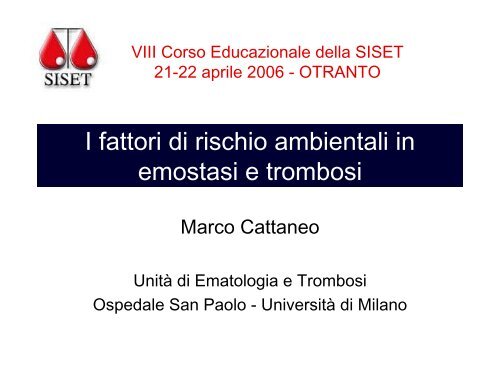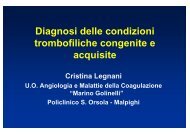I fattori di rischio ambientali delle malattie trombotiche e ... - Siset
I fattori di rischio ambientali delle malattie trombotiche e ... - Siset
I fattori di rischio ambientali delle malattie trombotiche e ... - Siset
Create successful ePaper yourself
Turn your PDF publications into a flip-book with our unique Google optimized e-Paper software.
VIII Corso Educazionale della SISET<br />
21-22 aprile 2006 - OTRANTO<br />
I <strong>fattori</strong> <strong>di</strong> <strong>rischio</strong> <strong>ambientali</strong> in<br />
emostasi e trombosi<br />
Marco Cattaneo<br />
Unità <strong>di</strong> Ematologia e Trombosi<br />
Ospedale San Paolo - Università <strong>di</strong> Milano
Fattore <strong>di</strong> <strong>rischio</strong><br />
• Un attributo che si osserva più comunemente<br />
in in<strong>di</strong>vidui che successivamente<br />
svilupperanno la malattia che in in<strong>di</strong>vidui che<br />
non svilupperanno la malattia<br />
• Il tipo <strong>di</strong> associazione tra la malattia e il<br />
fattore <strong>di</strong> <strong>rischio</strong> non è necessariamente<br />
causale
Criteri per la definizione <strong>di</strong><br />
• (plausibilità biologica)<br />
<strong>fattori</strong> <strong>di</strong> <strong>rischio</strong><br />
• Forza dell’associazione (<strong>rischio</strong> relativo)<br />
• Gra<strong>di</strong>ente biologico<br />
• Adeguato rapporto temporale (il <strong>rischio</strong> deve<br />
precedere la malattia)<br />
• In<strong>di</strong>pendenza da altri <strong>fattori</strong> <strong>di</strong> <strong>rischio</strong><br />
• Conferma dei risultati da stu<strong>di</strong> <strong>di</strong>versi<br />
• MODIFICAZIONE DEL FATTORE DI<br />
RISCHIO MODIFICA LA MALATTIA
Criteri per la definizione <strong>di</strong><br />
<strong>fattori</strong> <strong>di</strong> <strong>rischio</strong> CAUSALI<br />
• (plausibilità biologica)<br />
• Forza dell’associazione (<strong>rischio</strong> relativo)<br />
• Gra<strong>di</strong>ente biologico<br />
• Adeguato rapporto temporale (il <strong>rischio</strong> deve<br />
precedere la malattia)<br />
• In<strong>di</strong>pendenza da altri <strong>fattori</strong> <strong>di</strong> <strong>rischio</strong><br />
• Conferma dei risultati da stu<strong>di</strong> <strong>di</strong>versi<br />
• MODIFICAZIONE DEL FATTORE DI<br />
RISCHIO MODIFICA LA MALATTIA
Fattori <strong>di</strong> <strong>rischio</strong><br />
• Mo<strong>di</strong>ficabili/trattabili<br />
• Non mo<strong>di</strong>ficabili/non trattabili
Fattori <strong>di</strong> <strong>rischio</strong> per m. coronarica<br />
• LDL ><br />
• HDL <<br />
• trigliceri<strong>di</strong> ><br />
• ipertensione<br />
• <strong>di</strong>abete<br />
• obesità<br />
• Fumo<br />
1. mo<strong>di</strong>ficabili/trattabili<br />
• omocisteina<br />
• esercizio fisico<br />
• <strong>di</strong>eta<br />
• altri stili <strong>di</strong> vita<br />
• ………
Fattori <strong>di</strong> <strong>rischio</strong> per m. coronarica<br />
•età<br />
2. Non mo<strong>di</strong>ficabili/non trattabili<br />
•sesso<br />
• storia familiare<br />
• personalità<br />
• precedenti episo<strong>di</strong> car<strong>di</strong>ovascolari<br />
• aterosclerosi in altri <strong>di</strong>stretti<br />
• ………
• Ricerca<br />
Usi dei <strong>fattori</strong> <strong>di</strong> <strong>rischio</strong><br />
• Pratica clinica
Usi dei <strong>fattori</strong> <strong>di</strong> <strong>rischio</strong><br />
pratica clinica<br />
• Relazione causale non provata<br />
- pre<strong>di</strong>zione della probabilità <strong>di</strong> un in<strong>di</strong>viduo <strong>di</strong><br />
sviluppare quella malattia<br />
• Relazione causale provata<br />
- pre<strong>di</strong>zione della probabilità <strong>di</strong> un in<strong>di</strong>viduo <strong>di</strong><br />
sviluppare quella malattia<br />
- mo<strong>di</strong>ficazione del fattore <strong>di</strong> <strong>rischio</strong> per<br />
ridurre il <strong>rischio</strong> <strong>di</strong> sviluppare la malattia
Criteri per l’uso dei <strong>fattori</strong> <strong>di</strong> <strong>rischio</strong><br />
• Costo/efficacia<br />
• Applicabilità<br />
nella pratica clinica<br />
• Cambierà la gestione del paziente?<br />
– Aggiunge qualcosa a ciò che già so del paziente?<br />
– E’ mo<strong>di</strong>ficabile?
Uso dei <strong>fattori</strong> <strong>di</strong> <strong>rischio</strong> nella pratica clinica<br />
Chi dovrebbe essere stu<strong>di</strong>ato?<br />
• Popolazione generale?<br />
• Pazienti a <strong>rischio</strong>?
Uso dei <strong>fattori</strong> <strong>di</strong> <strong>rischio</strong> nella pratica clinica<br />
Chi dovrebbe essere stu<strong>di</strong>ato?<br />
• Popolazione generale?<br />
• Pazienti a <strong>rischio</strong>?<br />
Sì, ma:<br />
- pochi, costo-efficaci<br />
- mo<strong>di</strong>ficabili<br />
Sì, ma solo se cambia la<br />
gestione del paziente
Molecular genetics articles published<br />
Publications<br />
250<br />
200<br />
150<br />
100<br />
50<br />
0<br />
in Circulation<br />
1976-80 1981-85 1986-90 1991-95 1996-00<br />
hered. Dis.<br />
linkage<br />
mut., polym.<br />
genetics<br />
Milewicz and Seidman, 2000
Lo stu<strong>di</strong>o dei <strong>fattori</strong> <strong>di</strong> <strong>rischio</strong><br />
genetici è utile per definire il<br />
<strong>rischio</strong> <strong>di</strong> malattia?<br />
(aggiunge qualcosa?)<br />
?
FENOTIPO O GENOTIPO?<br />
?
Fattori <strong>di</strong> <strong>rischio</strong> per<br />
tromboembolismo venoso
Effetto dell’età e del sesso
Annual Incidence of VTE among Residents of Worchester (MA)<br />
In 1986 (by Age and Sex)<br />
Anderson et al, 1991
Effetto della razza/etnia
Age- and Sex-Adjusted Risk<br />
for VTE within 3 Months of a<br />
Specific Event among Different<br />
Ethnic Groups<br />
(Reference = Caucasians)<br />
(White et al, 1998)
Variazioni stagionali
Monthly Percentage Variations in French Hospital Admissions for Deep<br />
Vein Thrombosis and Pulmonary Embolism<br />
Boulay et al, 2001
Fattori <strong>di</strong> <strong>rischio</strong> per<br />
tromboembolismo venoso<br />
• Persistenti<br />
Ere<strong>di</strong>tari<br />
Acquisiti<br />
• Transitori (<strong>ambientali</strong>)
La Triade della Trombosi<br />
Sangue<br />
Flusso<br />
Vaso
Patogenesi della Trombosi<br />
Venosa<br />
• Alterazioni della parete vascolare<br />
• Alterazioni del flusso ematico<br />
• Alterazioni dell’emostasi
La Bilancia Emostatica<br />
Fattori della<br />
Coagulazione<br />
Anticoagulanti<br />
Naturali/Fibrinolisi<br />
Trombosi Emorragia
Sindromi Emofiliche<br />
Fattori della<br />
Coagulazione<br />
Anticoagulanti<br />
Naturali/Fibrinolisi<br />
Trombosi Emorragia
Sindromi Trombofiliche<br />
Fattori della<br />
Coagulazione<br />
Anticoagulanti<br />
Naturali/Fibrinolisi<br />
Trombosi Emorragia
Sindromi Trombofiliche<br />
Fattori della<br />
Coagulazione<br />
Anticoagulanti<br />
Naturali/Fibrinolisi<br />
Trombosi Emorragia
Fattori <strong>di</strong> <strong>rischio</strong> transitori<br />
Contraccettivi orali<br />
Terapia estrogenica sostituiva<br />
Gravidanza e puerperio<br />
Traumi<br />
Immobilizzazione prolungata<br />
Chirurgia
Sinergismo tra <strong>fattori</strong> <strong>di</strong> <strong>rischio</strong> per TEV
Cases of Deep-Vein Thrombosis per 10,000 Person-Years, Accor<strong>di</strong>ng to<br />
the Use of Oral Contraceptives and the Presence of Factor V Leiden<br />
Vandenbroucke et al, 2005
Rischio <strong>di</strong> reci<strong>di</strong>va
Kaplan-Meier Estimates of the Likelihood of<br />
Recurrent Venous Thromboembolism Accor<strong>di</strong>ng to Sex<br />
Kyrle et al, 2004
Cumulative incidence of recurrent thrombotic events<br />
Christianses et al, 2005
Cumulative proportions of recurrent thrombosis in patients with and<br />
without laboratory evidence of a heritable thrombophilic defect<br />
Baglin et al, 2003
Cumulative proportion of recurrent thrombosis after<br />
cessation of anticoagulant therapy<br />
Group A: surgery in the previous 6 weeks<br />
Group C: patients with unprecipitated venous thromboembolism in whom there was no identifiable<br />
clinical risk factor<br />
Group D: patients with non surgical risk factors for VTE<br />
Baglin et al, 2003
Recurrence rates by oral contraceptive use in 215 women<br />
between 16 and 55 years<br />
Christianses et al, 2005
Relative risk of VTE for quartiles of<br />
PLP<br />
1st Qle vs 4th Qle<br />
PLP<br />
Crude OR<br />
(95% CI)<br />
1.5<br />
(1.0-2.1)<br />
Adjusted* OR<br />
(95% CI)<br />
1.8<br />
(1.2 – 2.8)<br />
1st Qle: 46.5 nmol/L<br />
*Adjusted for: age, gender, factor V Leiden, G20210 factor II, folate,<br />
cobalamin, tHcy<br />
Cattaneo et al, 2001
Cumulative Probability of Recurrence of VTE Accor<strong>di</strong>ng to Baseline<br />
Plasma PLP Levels<br />
Probability of Recurrence (%)<br />
No. of Patients at Risk<br />
PLP < 15th percentile<br />
PLP > 15th percentile<br />
50<br />
40<br />
30<br />
20<br />
10<br />
0<br />
PLP < 23.3 nmol/L<br />
PLP > 23.3 nmol/L<br />
RR= 1.6 (0.99-2.57)<br />
0 2 4 6 8<br />
117<br />
649<br />
Years from Discontinuation of Anticoagulant Therapy<br />
58<br />
361<br />
41<br />
190<br />
22<br />
88<br />
6<br />
46<br />
Cattaneo et al, 2003
Proportion with recurrent VTE<br />
p p<br />
0.00 0.05 0.10 0.15 0.20 0.25 0.30<br />
Cumulative Hazard Estimates<br />
Placebo Group<br />
PLP10 th percentile<br />
0 .5 1 1.5 2 2.5<br />
Years<br />
RR 2.4 (1.2 - 4.9)<br />
RR 2.0 (0.8 – 4.6) after adjustement for tHcy Cattaneo et al, 2005
Proportion with recurrent VTE<br />
Effects of vitamin supplementation on<br />
VTE recurrence<br />
Overall effect vitamin supplementation RR=0.84 (95%CI 0.56 – 1.26)<br />
0.00 0.05 0.10 0.15 0.20 0.25 0.30<br />
PLP 10th percentile<br />
0 .5 1 1.5 2 2.5<br />
years<br />
Placebo Vitamins<br />
RR=0.92 (0.59 – 1.42)<br />
Cattaneo et al, 2005
Proportion with recurrent VTE<br />
Effects of vitamin supplementation on<br />
VTE recurrence<br />
Overall effect vitamin supplementation RR=0.84 (95%CI 0.56 – 1.26)<br />
0.00 0.05 0.10 0.15 0.20 0.25 0.30<br />
PLP 10th percentile<br />
0 .5 1 1.5 2 2.5<br />
years<br />
Placebo Vitamins<br />
RR=0.56 (0.19 –1.69) RR=0.92 (0.59 – 1.42)<br />
Cattaneo et al, 2005
Genes and organism<br />
• … of course it is true that lions look <strong>di</strong>fferent<br />
from lambs and chimps from humans, and a<br />
satisfactory explanation for the <strong>di</strong>fferences<br />
between lions, lambs, chimps and us need<br />
not involve other causal factors (than genes)<br />
• But if we want to know why two lambs are<br />
<strong>di</strong>fferent from one another, a description of<br />
their genetic <strong>di</strong>fferences is insufficient and for<br />
some of their characteristics may even be<br />
irrelevant<br />
R. Lewontin, 2000
Effects of environmental quality (year/location)<br />
on the yield of corn from 2 <strong>di</strong>fferent maize hybrids<br />
Yield of corn<br />
100<br />
80<br />
60<br />
40<br />
20<br />
Environmental quality<br />
variety 1<br />
variety 2<br />
Suzuki et al, 1996
Number of facets<br />
Size of the eye, measured as number of cells in<br />
<strong>di</strong>fferent genotypes of Drosophila<br />
1000<br />
100<br />
10<br />
Temperature (°C)<br />
wild type<br />
infrabar<br />
ultrabar<br />
Suzuki et al, 1996
tHcy (µM)<br />
50<br />
40<br />
30<br />
20<br />
10<br />
0<br />
Relationship between folate<br />
and tHcy levels<br />
0 10 20 30<br />
Ln folate (µg/ml)<br />
wt MTHFR<br />
TT MTHFR<br />
Verhoeff et al, 1998
Den Heijer et al, 2005
Den Heijer et al, 2005
XIX Congresso della Società Italiana per lo Stu<strong>di</strong>o<br />
dell’Emostasi e della Trombosi (SISET)<br />
14-17 settembre 2006<br />
Università degli Stu<strong>di</strong> <strong>di</strong> Milano<br />
www.siset2006.org




